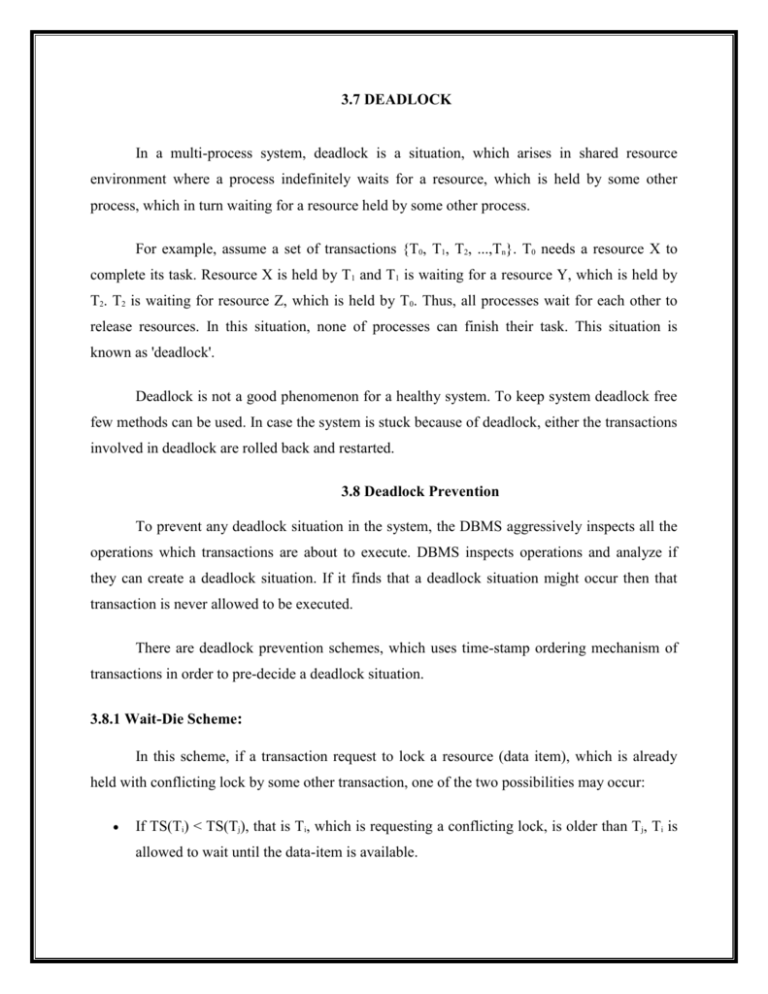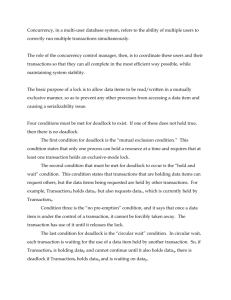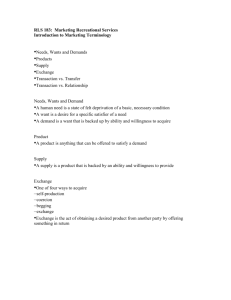deadlock - SNS Courseware
advertisement

3.7 DEADLOCK
In a multi-process system, deadlock is a situation, which arises in shared resource
environment where a process indefinitely waits for a resource, which is held by some other
process, which in turn waiting for a resource held by some other process.
For example, assume a set of transactions {T0, T1, T2, ...,Tn}. T0 needs a resource X to
complete its task. Resource X is held by T1 and T1 is waiting for a resource Y, which is held by
T2. T2 is waiting for resource Z, which is held by T0. Thus, all processes wait for each other to
release resources. In this situation, none of processes can finish their task. This situation is
known as 'deadlock'.
Deadlock is not a good phenomenon for a healthy system. To keep system deadlock free
few methods can be used. In case the system is stuck because of deadlock, either the transactions
involved in deadlock are rolled back and restarted.
3.8 Deadlock Prevention
To prevent any deadlock situation in the system, the DBMS aggressively inspects all the
operations which transactions are about to execute. DBMS inspects operations and analyze if
they can create a deadlock situation. If it finds that a deadlock situation might occur then that
transaction is never allowed to be executed.
There are deadlock prevention schemes, which uses time-stamp ordering mechanism of
transactions in order to pre-decide a deadlock situation.
3.8.1 Wait-Die Scheme:
In this scheme, if a transaction request to lock a resource (data item), which is already
held with conflicting lock by some other transaction, one of the two possibilities may occur:
If TS(Ti) < TS(Tj), that is Ti, which is requesting a conflicting lock, is older than Tj, Ti is
allowed to wait until the data-item is available.
If TS(Ti) > TS(tj), that is Ti is younger than Tj, Ti dies. Ti is restarted later with random
delay but with same timestamp.
This scheme allows the older transaction to wait but kills the younger one.
3.8.2 Wound-Wait Scheme:
In this scheme, if a transaction request to lock a resource (data item), which is already
held with conflicting lock by some other transaction, one of the two possibilities may occur:
If TS(Ti) < TS(Tj), that is Ti, which is requesting a conflicting lock, is older than Tj, Ti
forces Tj to be rolled back, that is Ti wounds Tj. Tj is restarted later with random delay but
with same timestamp.
If TS(Ti) > TS(Tj), that is Ti is younger than Tj, Ti is forced to wait until the resource is
available.
This scheme, allows the younger transaction to wait but when an older transaction request an
item held by younger one, the older transaction forces the younger one to abort and release the
item.
In both cases, transaction, which enters late in the system, is aborted.
3.8.3 Deadlock Avoidance
Aborting a transaction is not always a practical approach. Instead deadlock avoidance
mechanisms can be used to detect any deadlock situation in advance. Methods like "wait-for
graph" are available but for the system where transactions are light in weight and have hold on
fewer instances of resource. In a bulky system deadlock prevention techniques may work well.
Wait-for Graph
This is a simple method available to track if any deadlock situation may arise. For each
transaction entering in the system, a node is created. When transaction Ti requests for a lock on
item, say X, which is held by some other transaction Tj, a directed edge is created from Ti to Tj. If
Tj releases item X, the edge between them is dropped and Ti locks the data item.
The system maintains this wait-for graph for every transaction waiting for some data
items held by others. System keeps checking if there's any cycle in the graph.
Examples :
Two approaches can be used, first not to allow any request for an item, which is already
locked by some other transaction. This is not always feasible and may cause starvation, where a
transaction indefinitely waits for data item and can never acquire it. Second option is to roll back
one of the transactions.
It is not feasible to always roll back the younger transaction, as it may be important than
the older one. With help of some relative algorithm a transaction is chosen, which is to be
aborted, this transaction is called victim and the process is known as victim selection.
3.8.4 Dealing with Deadlock and Starvation
Deadlock occurs when each transaction T in a set of two or more transactions is waiting
for some item that is locked by some other transaction T_ in the set. Hence, each transaction in
the set is in a waiting queue, waiting for one of the other transactions in the set to release the lock
on an item. But because the other transaction isalso waiting, it will never release the lock.
A simple example is shown in Figure22.5(a), where the two transactions T1_and T2_ are
deadlocked in a partial schedule;T1_ is in the waiting queue for X, which is locked by T2_, while
T2_ is in the waiting queue for Y, which is locked by T1_. Meanwhile, neither T1_ nor T2_ nor
any other transaction can access items X and Y.
Deadlock Prevention Protocols. One way to prevent deadlock is to use a deadlock prevention
protocol.
One deadlock prevention protocol, which is use in conservative two-phase locking, requires that
every transaction lock all the items it needs in advance (which is generally not a practical
assumption)—if any of the items cannot be obtained, none of the items are locked. Rather, the
transaction waits and then tries again to lock all the items it needs. Obviously this solution
further limits concurrency.
A second protocol, which also limits concurrency, involves ordering all the items in the
database and making sure that a transaction that needs several items will lock them according to
that order. This requires that the programmer (or the system) is aware of the chosen order of the
items, which is also not practical in the database context.
A number of other deadlock prevention schemes have been proposed that make a
decision about what to do with a transaction involved in a possible deadlock situation: Should it
be blocked and made to wait or should it be aborted, or should the transaction preempt and abort
another transaction.
Some of these techniques use the concept of transaction timestamp TS(T), which is a
unique identifier assigned to each transaction. The timestamps are typically based on the order in
which transactions are started; hence, if transaction T1 starts before transaction T2, then TS(T1)
< TS(T2). Notice that the older transaction (which starts first) has the smaller timestamp value.
Two schemes that prevent deadlock are called wait-die and woundwait. Suppose that transaction
Ti tries to lock an item X but is not able to because X is locked by some other transaction Tj with
a conflicting lock. The rules followed bythese schemes are:
■ Wait-die. If TS(Ti) < TS(Tj), then (Ti older than Tj) Ti is allowed to wait;
otherwise (Ti younger than Tj) abort Ti (Ti dies) and restart it later with the same
timestamp.
■ Wound-wait. If TS(Ti) < TS(Tj), then (Ti older than Tj) abort Tj (Ti wounds
Tj) and restart it later with the same timestamp; otherwise (Ti younger than Tj) Ti is
allowed to wait.In wait-die, an older transaction is allowed to wait for a younger
transaction,





